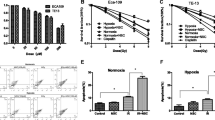Abstract
Purpose
Adjunct chemoradiation is offered to unresectable esophageal squamous cell carcinoma (ESCC) patients, while its use is limited in tumors with strong resistance. Oxygen carriers or anti-hypoxic drugs belong to an emerging class of regulators that can alleviate tumor hypoxia.
Methods
We investigate the potential use of a novel oxygen carrier YQ23 in sensitizing chemoresistant ESCC in a series of subcutaneous tumor xenograft models developed using ESCC cell lines with different strengths of chemosensitivities.
Results
Tumor xenografts were developed using SLMT-1 and HKESC-2 ESCC cell lines with different strengths of resistance to two chemotherapeutic drugs, 5-fluorouracil and cisplatin. More resistant SLMT-1 xenografts responded better to YQ23 treatment than HKESC-2, as reflected by the induced tumor oxygen level. YQ23 sensitized SLMT-1 xenografts toward 5-fluorouracil via its effect on reducing the level of a hypoxic marker HIF-1α. Furthermore, a derangement of tumor microvessel density and integrity was demonstrated with a concurrent decrease in the level of a tumor mesenchymal marker vimentin. Similar to the 5-fluorouracil sensitizing effect, YQ23 also enhanced the response of SLMT-1 xenografts toward cisplatin by reducing the tumor size and the number of animals with invasive tumors. Chemosensitive HKESC-2 xenografts were irresponsive to combined YQ23 and cisplatin treatment.
Conclusions
In all, YQ23 functions selectively on chemoresistant ESCC xenografts, which implicates its potential use as a chemosensitizing agent for ESCC patients.





Similar content being viewed by others
References
Tong DK, Law S, Kwong DL et al (2011) Current management of cervical esophageal cancer. World J Surg 35:600–607
Law S, Kwong DL, Kwok KF et al (2003) Improvement in treatment results and long-term survival of patients with esophageal cancer: impact of chemoradiation and change in treatment strategy. Ann Surg 238:339–347 (discussion 347–338)
Law S, Wong J (2007) The current management of esophageal cancer. Adv Surg 41:93–119
Gundersen SI, Palmer AF (2008) Hemoglobin-based oxygen carrier enhanced tumor oxygenation: a novel strategy for cancer therapy. Biotechnol Prog 24:1353–1364
Liu XB, Cheng Q, Geng W et al (2014) Enhancement of cisplatin-based TACE by a hemoglobin-based oxygen carrier in an orthotopic rat HCC model. Artif Cells Nanomed Biotechnol 42:229–236
Robinson MF, Dupuis NP, Kusumoto T et al (1995) Increased tumor oxygenation and radiation sensitivity in two rat tumors by a hemoglobin-based, oxygen-carrying preparation. Artif Cells Blood Substit Immobil Biotechnol 23:431–438
Li CX, Wong BL, Ling CC et al (2014) A novel oxygen carrier “YQ23” suppresses the liver tumor metastasis by decreasing circulating endothelial progenitor cells and regulatory T cells. BMC Cancer 14:293
Hu YC, Lam KY, Law SY et al (2002) Establishment, characterization, karyotyping, and comparative genomic hybridization analysis of HKESC-2 and HKESC-3: two newly established human esophageal squamous cell carcinoma cell lines. Cancer Genet Cytogenet 135:120–127
Tang JC, Wan TS, Wong N et al (2001) Establishment and characterization of a new xenograft-derived human esophageal squamous cell carcinoma cell line SLMT-1 of Chinese origin. Cancer Genet Cytogenet 124:36–41
Fatima S, Lee NP, Tsang FH et al (2012) Dickkopf 4 (DKK4) acts on Wnt/beta-catenin pathway by influencing beta-catenin in hepatocellular carcinoma. Oncogene 31:4233–4244
Wang Y, Shek FH, Wong KF et al (2013) Anti-cadherin-17 antibody modulates beta-catenin signaling and tumorigenicity of hepatocellular carcinoma. PLoS One 8:e72386
Chan KT, Choi MY, Lai KK et al (2014) Overexpression of transferrin receptor CD71 and its tumorigenic properties in esophageal squamous cell carcinoma. Oncol Rep 31:1296–1304
Hui MK, Chan KW, Luk JM et al (2012) Cytoplasmic Forkhead box M1 (FoxM1) in esophageal squamous cell carcinoma significantly correlates with pathological disease stage. World J Surg 36:90–97
El-Kenawy AE, Lotfy M, El-Kott A et al (2005) Significance of matrix metalloproteinase 9 and CD34 expressions in esophageal carcinoma: correlation with DNA content. J Clin Gastroenterol 39:791–794
Ben Lassoued A, Beaufils N, Dales JP et al (2013) Hypoxia-inducible factor-1a as prognostic marker. Expert Opin Med Diagn 7:53–70
Voulgari A, Pintzas A (2009) Epithelial-mesenchymal transition in cancer metastasis: mechanisms, markers and strategies to overcome drug resistance in the clinic. Biochim Biophys Acta 1796:75–90
Satelli A, Li S (2011) Vimentin in cancer and its potential as a molecular target for cancer therapy. Cell Mol Life Sci 68:3033–3046
Dai M, Yu M, Han J et al (2008) PEG-conjugated hemoglobin combination with cisplatin enforced the antiangiogeic effect in a cervical tumor xenograft model. Artif Cells Blood Substit Immobil Biotechnol 36:487–497
Han J, Yu M, Dai M et al (2008) Effect of artificial oxygen carrier with chemotherapy on tumor hypoxia and neovascularization. Artif Cells Blood Substit Immobil Biotechnol 36:431–438
Mallet V, Dutheil D, Polard V et al (2014) Dose-ranging study of the performance of the natural oxygen transporter HEMO2 Life in organ preservation. Artif Organs 38:691–701
Kaneda S, Ishizuka T, Sekiguchi A et al (2014) Efficacy of liposome-encapsulated hemoglobin in a rat model of cerebral ischemia. Artif Organs 38:650–655
Swyer TW, Strom J, Larson DF (2014) Nanoparticle oxygen delivery to the ischemic heart. Perfusion 29:539–543
Acknowledgments
This study was financially supported by research and development service agreement with New B Innovation Limited, Hong Kong.
Author information
Authors and Affiliations
Corresponding authors
Ethics declarations
Conflict of interest
Co-authors Fei Chuen Tzang, Heron Han, Ian P. Y. Lam, Sui Yi Kwok, Sze Hang Lau, Cornelia Man, and Bing L. Wong were under the employment of New B Innovation Limited when this study was performed. Other authors did not have any conflict of interest to declare.
Electronic supplementary material
Below is the link to the electronic supplementary material.
280_2015_2897_MOESM1_ESM.tif
Supplementary Figure 1: YQ23 demonstrates no obvious chemosensitizing effect towards cisplatin in cisplatin-sensitive HKESC-2 xenografts Treatment of cisplatin-sensitive HKESC-2 xenografts with cisplatin led to an obvious reduction in tumor size. However, such tumor reducing effect mediated by cisplatin (cisplatin) remained the same even after combined treatment with YQ23 (YQ23/cisplatin). This demonstrates YQ23 did not associate with any extra tumor-reducing effect on chemo-sensitive HKESC-2 xenografts (TIFF 793 kb).
Rights and permissions
About this article
Cite this article
Lee, N.P., Chan, K.T., Choi, M.Y. et al. Oxygen carrier YQ23 can enhance the chemotherapeutic drug responses of chemoresistant esophageal tumor xenografts. Cancer Chemother Pharmacol 76, 1199–1207 (2015). https://doi.org/10.1007/s00280-015-2897-2
Received:
Accepted:
Published:
Issue Date:
DOI: https://doi.org/10.1007/s00280-015-2897-2




